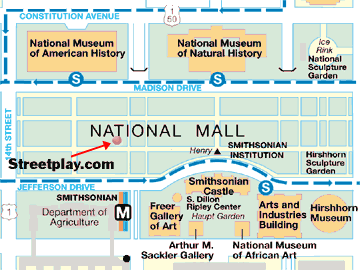



|
Just put a sidewalk on the grass and we're set, yo
|

|
Our location on the National Mall (see more info about the Mall on the National Park Service
site, opens in new window)
|
The 2001 Folklife Festival marked the 35th time the Smithsonian Institution
sponsored and staged the event, nestled neatly on Washington DC's National
Mall betwixt the Washington Monument and the Capitol building (adjacent to the
Smithsonian Castle). During its 10 days (June 27-July 1 and July 4-July 8),
it's estimated that over a million people visited the hundreds of participants
representing various themes of the folk cultures of Bermuda, New York City,
and the Building Arts.
The Smithsonian turned the Mall into a city of tents, each one dedicated to a
certain participant's activities. Some tents served as mini-amphitheaters
with different musical performers rotating all day; others had more permanent
installations (like Streetplay). The Smithsonian specially constructed props
for certain participants--our mockup of a brownstone in front of a
specially-poured slab of concrete sidewalk was arguably the most elaborate
installation on the mall (at the very least, it was among the tallest). Some
native DC'ers jokingly asked whether our brownstone was "going condo."
Streetplay brought the indigenous street games of NYC to literally thousands
of people who visited us. Perhaps by design, our installation was closest to
the Smithsonian stop on the Metro, DC's clean little subway system. An
authentic NYC MTA subway car and city bus sat adjacent to our stoop,
completing the public transportation motif.
While we didn't count the number of people who visited our "block," we
estimate 8-10 thousand people came by (we're guessing about 150 people/hour
over 60 hours of the festival). We collected about 350 names and e-mail
addresses from people, and gave out exactly $54,387 in Streetplay money (actually, we
have no clue how much we gave out).
Aside from a daily fungo stickball event, the games we played the most were
Ace-King-Queen, stoopball, jump rope and skully. Many were familiar with, or had
forgotten, these games, while more learned the games on the spot and became
quite competitive. For those who had enough time to spend, skully proved
surprisingly popular with newcomers, especially considering the relative
complexity of the game. Those familiar with stoopball were evenly divided on
how they liked to play it (either for points, or as a baseball simulation).
As for Ace-King-Queen, people generally had trouble getting their head wrapped
around the idea of hitting the ball on the ground first (as opposed to
conventional handball). Even so, the line of people wanting to play it were
probably the longest of any game we were playing (we came up with new scoring
rules to keep it moving).
Despite a blistering heat in the first week of the festival, followed the next
by hail and lightning storms, our guests and our staff survived, using a lot
of sunscreen and drinking plenty of fluids. In the spirit of the competition,
though, one of our weekend volunteers injured her wrist playing stoopball, and
an otherwise fit-looking guest wrenched his back while showing his sons how to
play Ace-King-Queen (he was one of a surfeit of misplaced New Yorkers now
living in the DC area). All other injuries were confined to the pride of
people who struck out playing stickball.
|
